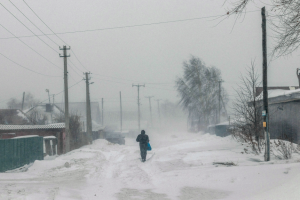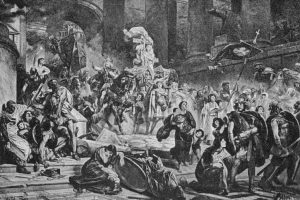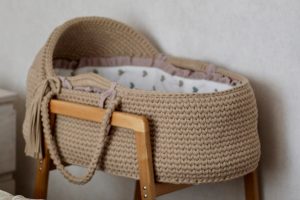In an image painted by Father William Hart McNichols, Our Lady of Sorrows reaches out her arms to Alana Chen, a young LGBTQ+ woman who died by suicide in 2019. Chen was a devout Catholic who underwent conversion therapy.
When painting the image of Chen, McNichols imagined who she was with now. He wrote: “Who better than Our Lady of Sorrows to reach down to catch Alana and bring her home?”
On Febuary 5, the Association of U.S. Catholic Priests hosted a webinar called “Conversations in the Spirit: Understanding and honoring the lived experience of our LGBTQ+ Catholic siblings, parents, family, priests, and allies.” Inspired by McNichols’ image and Chen’s story, the webinar was dedicated in memory of Chen and to Our Lady of Sorrows.
The speakers, breakout rooms, imaginative prayer exercises, and Q&A conversations explored the questions: What makes LGBTQ+ Catholics stay in the church, and how can the church be better at welcoming LGBTQ+ people?
Joyce Calvo, Chen’s mother, shared her story on the call. Yunuen Trujillo and Father Bryan Massingale spoke about being out as LGBTQ+ Catholics in their ministries. Bishop John Stowe was present for the Q&A portion and led the closing prayer. There were over 300 people on the call.
The event was led by the Women in the Church working group within the Association of U.S. Catholic Priests, and the conversations in the spirit portion of the call was facilitated by Ignatian Encounter Ministry.
On the call, Calvo, Chen’s mother, urged parents to be aware of the impact that the church can have on LGBTQ+ children. “No child should ever be robbed of their ability to love and be loved by God and by their church,” she said. “Every child deserves to know that they are not broken, they are not sinful; they are loved.”
When Chen was 14, she attended two Catholic summer camps in Boulder, Colorado and became deeply devout—she served those who are poor and marginalized, lived her faith, and embodied Christ’s love, Calvo says. But during these camps, “priests and nuns were telling her that being gay was a mortal sin,” making Chen “believe that who God created her to be was a danger to her soul.”
“Did they have any right to teach this at what seemed like a good and fun camp, to learn more about God, Jesus, and the religion?” Calvo said. “And parents like myself are kept in the dark.”
Calvo noticed a change in Chen after these camps. One of the priests Chen told about her “same-sex attraction” told her to become a nun and not tell her parents because they would be accepting of her sexuality. Another priest advised her to apply for Desert Stream Living Waters Program, which advertises “helping people from unwanted same-sex attraction.” Calvo said Chen unknowingly entered conversion therapy disguised as spiritual direction.
“It is clear from Alana’s journals, and what she told me before she died, that priests and other representatives of the church encouraged her to conceal and suppress her sexual orientation,” Calvo said. “Again and again in her journals she wrote, ‘I am so tired of being afraid of going to hell.’”
Calvo read aloud from a letter Chen wrote to herself shortly before her death: “Dear Alana, you are just a little girl, but you really don’t like yourself. . . . I wish you could see that the people who love you, the people that matter, they don’t hold you to those standards. . . . Those other people that left, that walked away . . . they can’t handle your light.”
Yunuen Trujillo, a minister and author, as well as a columnist for U.S. Catholic, said on the call that she “stays in the church because of Jesus,” but understands why people leave. For many LGBTQ+ Catholics, “the church is an emotionally toxic space,” she said.
Trujillo stressed her intersectional identities as an immigrant, Latina, woman, and LGBTQ+ Catholic. Her family came to the United States when she was 16, and “as an immigrant needing community,” she decided to go back into the closet after coming out to her mom as a teenager.
Trujillo said she had a bit of a crisis after she came out again 10 years later, after building a history of ministry in the Catholic Church. She wondered, as an LGBTQ+ Catholic who is not called to be single: “Will there be a place for me in this church?”
Trujillo urged those on the call to go through a “10-year process of discernment” like she did by listening to as many LGBTQ+ stories as you can, especially the stories of trans people right now. “In the church, we’re supposed to follow a preferential option for the poor and vulnerable, and if we don’t listen to these stories, we will never understand how these communities are so vulnerable.”
Like Trujillo, Father Bryan Massingale, a professor at Fordham and author, says intersectionality is important in understanding his experience in the church. “I come to you as a Black gay priest,” he said.
Massingale said he was out as a gay man for many years before he became publicly out. “Making a public declaration of one’s sexuality, especially as a priest, is still pretty unusual,” he said. “I didn’t do this in order to say look at me, I’m a gay priest. But to say I am here with you. I can no longer do the ministry that I’m doing unless I’m willing to share in the vulnerability of this community.”
Massingale said the majority of problems he has faced from being publicly out have come from clergy and bishops, not laypeople.
Gay priests have a complicated role in the church, Massingale said. “How long do we serve a church that does not appreciate who we are? I stay because this is where God has called me. God knew who I was and what I was when I received the call to ordination. The problem is not on God’s end, and the problem is not on the laity’s end, the problem is with the church as an institution and with all too many of our ordained leaders.”
During the Q&A portion, people asked questions about working for the church in an official capacity and holding onto one’s faith in spite of bigotry.
Stowe said he sees his role as being a “fellow pilgrim on the journey with everybody else. I also have to maintain my integrity. I don’t hide my disagreement with a lot of what the USCCB does, even though I would be encouraged to do so. But I think unity comes out of directly confronting those things.”
The webinar included breakout rooms and conversations. Ariell Watson Simon, a chaplain, spiritual director, and LGBTQ+ Catholic, led a time of Ignatian prayer, prompting those on the call to “imagine a Catholic Church that is inclusive and supports LGBTQ+ people and families. What comes to mind when you imagine that? How would the church need to be focused or structured to accomplish that goal?”
The results and notes from the webinar will be submitted to the Dicastery in Rome and the USCCB synodal office. Stowe closed the call with a prayer to “bless all of those” who are making the church what God wants it to be.
Some resources that organizers of the webinar shared were the 988 Suicide and Crisis Lifeline, in which anyone at risk of suicide can call or text 988, The Trevor Project, and the Alana Faith Chen Foundation, which fights to ensure every LGBTQ+ person at risk of suicide has access to all the treatment they need.
Image: From Women and Priests, Conversations in the Spirit Webinar












Add comment